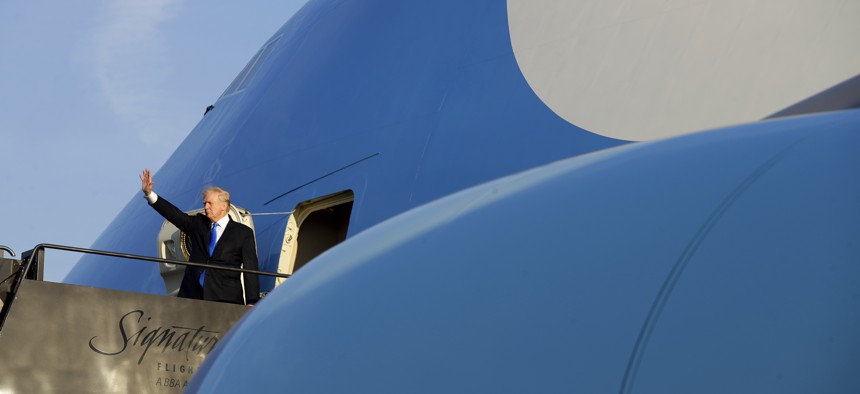
President Donald Trump waves as he boards Air Force One at Newark Liberty International Airport in Newark, N.J., Sunday, June 11, 2017. Patrick Semansky/AP
The Trump Administration Is Making Good Policy
It’s the president himself who’s destroying it.
Remember the iconic New Yorker cover with Manhattan as the towering center of the world, all else minuscule, nothing between the Atlantic and Pacific coastal cities? Americans and the world are once again getting a lesson in relative geography. Because no distance seems as large as that between the national-security office buildings of the American government and the White House in the Trump administration.
If one listened only to the admirable secretary of defense, or most of the statements by the secretary of state, one would surmise the Trump administration to be well within the boundaries of traditional American post-World War II national-security policy. The National Security Council staff evidently has the interagency process running to identify policy problems and assess potential solutions. The electrical current jumps the grid, though, when issues cross the the narrow drive called West Executive Avenue that divides the White House from the Eisenhower Executive Office Building where the NSC resides.
The Afghanistan strategy review illustrates the problem. The war in Afghanistan has been fought by Americans and their allies for 16 years, with no victory in sight. America’s military believes the war is winnable, if only Presidents Bush and Obama’s limitations on time and troops were lifted. The secretary of defense is perhaps not surprisingly also of the view that our country should endeavor to win the wars it is fighting. The secretary of state blanches at what would be needed of America’s diplomats and foreign assistance to bring the necessary whole of government approach into being, but evidently also supports increasing our country’s effort. The intelligence agencies conclude that 16 of the 22 most dangerous terrorist organizations exist in the Afghanistan-Pakistan region and will become major threats to the U.S. homeland if the war in Afghanistan is abandoned. In any normal administration, that would be a consensus. And it evidently was, until the policy crossed West Executive Avenue.
Surmising that opposition among the disputatious political factions closest to the president posed a significant threat of the president deciding to pull out of Afghanistan, the national-security adviser pulled the policy back from consideration. Perhaps he awaits a more propitious time. Perhaps the Cabinet has work to do with the president to immunize him against his political advisers on this crucial national-security issue. Perhaps they await developments within Afghanistan that will make the case for them (as the Bush administration awaited political developments in Iraq on so many occasions).
In any event, the president is now five months in office without having determined his policy on the war. Authority has been ceded to the Pentagon to determine force levels and operational decisions, but no policy is in place to guide the Defense Department’s judgments. President Trump seems contented with this purgatory, which allows him to take credit for any successes and blame “the generals” for any failures. But it is bad policy, and bad policy making.
And it seems to be business as usual in the Trump administration. Policy processes produce sensible policies that are then upended by the president’s decisions—tweets whipping up sentiment against Qatar as GCC relations approach the precipice, which have to be hurriedly managed by the secretaries of state and defense, or, as yesterday, comments to the press diametrically opposed to the position Secretary Tillerson is simultaneously announcing about the Gulf crisis; advance assurance by U.S. diplomats to European governments that the president would explicitly endorse NATO’s Article 5 made false by West Wing excisions from the speech, leaving the national-security adviser and others holding the president’s coat and insisting that even if the president didn’t say it, he meant it, until the president finally relented two weeks later.
The national-security adviser sits in the West Wing of the White House. That, too, seems fitting, since Lieutenant General H.R. McMaster has aligned himself more with the president than with the rest of the U.S. government. General McMaster is not simply providing analysis and coordination of national-security issues, he has crossed the road to become the president’s defender. When President Trump shared highly classified information with the Russians, General McMaster described the president’s actions as “wholly appropriate.” When the president’s overseas trip drew criticism, General McMaster and National Economic Council director Gary Cohn published the clearest statement of the president’s approach to national security, one that considers no alliance more than temporary alignment of policies. This is how the liberal order ends, with the United States disavowing it.
Germany’s chancellor drew considerable attention for her statement that Europe must rely more on itself because others (meaning the U.S.) are no longer reliable. Australia’s prime minister said basically the same thing at the Shangri-La defense dialogue, as did Canada’s foreign minister in a speech to parliament. America’s closest friends are in agreement that the width of West Executive Avenue has made the United States an unreliable ally.




